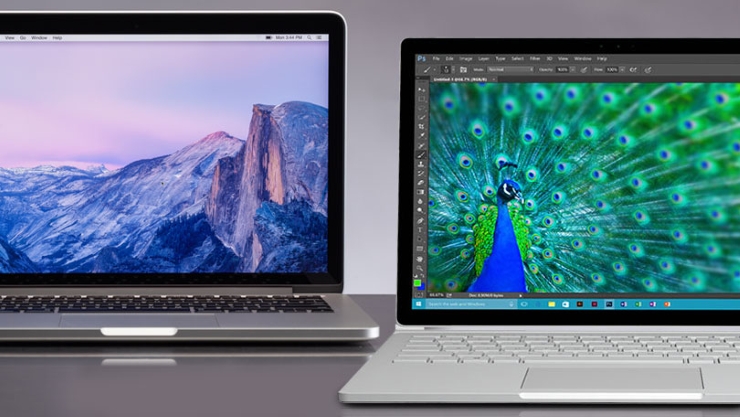In one corner, sits Microsoft Surface Book: a 13.5 inch screen size, Windows 10 ultraportable with one heck of a hat-trick, in the form of a detachable display that turns into a stand-alone tablet with included stylus, running Microsoft latest and best version of its Windows operating system.

This is no 2012 Surface tablet, not even close. The Surface Book packs a Skylake Intel Core i5 or i7 CPU, up to 16GB of RAM, an NVIDIA discrete GPU good enough to play Rise of the Tomb Raider at more than decent settings, driving a native resolution of 3000 x 2000 pixels (267ppi).
The aspect ration of the Surface Book is 3:2, which is designed to fit the aspect ration of a A4 sheet of paper, especially when using the Surface Book in tablet mode with the Surface Pen.
In the opposite corner sits the 13 inch Apple MacBook Pro, powered by a 2.9GHz 3rd generation Intel Core i5 or i7, with 8GB or RAM, and 512GB of PCIe flash storage.
No MacBook will ever feature a touchscreen, at least according to Apple CEO Tim Cook. With that said, with the exception of it lacking the ability to transform into an iPad Pro, the MacBook Pro’s specs are in line with what enterprise customers expect, especially when running an operating system as tightly optimized for its hardware, as Mac OS X.
With rumors hinting to a Surface Book 2 in the making, to be released sometime in the last quarter of 2016, it seems appropriate to think that Apple has something in store of its own. After all, when the Surface Book was first released in October of last year, Apple did catch an opportunity to throw a friendly zinger or two during the unveiling of the 12.9 inch iPad Pro, less than a month later, which sets the stage for a hardware-centered rivalry, that is almost first of its kind, as Apple’s former rival used to be the entire collective of Windows PC manufacturers.
With Microsoft now gaining ground as a PC manufacturer, with an increasingly solid Surface brand, a return of “I’m a Mac, and I’m a PC”, or rather “I’m from Cupertino, and i’m from Redmond”, seems more plausible, which explains clues of Apple doing some brand restructuring of its own.
What is exactly in store for consumers and fans of Microsoft Surface Book and MacBook Pro product lines, and how fierce will the competition be?
The theories are narrowing around the specs and design of two devices that for the moment, are still completely unofficial and speculative at best. With that said, Microsoft can’t afford to lose momentum on its Surface line, which means that a Surface Book 2 is most definitely in the cards.
Aside from a very possible USB Type-C port, which some are saying it could make its appearance in the Surface Pro 5 (also still a rumor), a 4K display could find its way into a Surface Book refresh, this year, as well as improved battery life, and a faster processor, possibly in the range of a 3.0GHz Intel Core i5 or i7 Skylake, and a similar, but more energy efficient NVIDIA GPU.
Rumors of an incredibly thin MacBook Pro, have been mounting, as the next generation MacBook is predicted to be built with hinges manufactured using metal-injection, a process that has allowed Apple, as well as Microsoft, to build micro-components able to fit in amazingly tight spaces within their hardware internals. It’s also plausible that the new device will be powered by an Intel Core Skylake CPU, and feature a USB Type-C connector, as well as support for Thunderbolt 3.